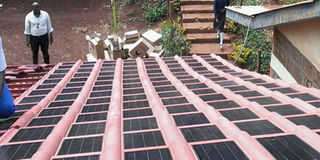We can improve our clean power status

A building in Nairobi is fitted with solar panels. So far, the renewable industry in general and solar photovoltaic sector specifically have their work cut out for them. PHOTO | FILE | NATION MEDIA GROUP
What you need to know:
- The challenges of scale can be better addressed by designing strategy and executing them in alignment with government commitment to the renewable industry.
- For public institutions, investments in large solar arrays (like Strathmore) cannot only eliminate energy bills but, if well done, can bring in supplementary income.
That Kenya is a powerhouse in renewable energy has been confirmed by its listing among the top five fastest-growing solar energy markets in Africa last year.
According to an analysis by Solar Plaza International BV, the five countries contributed a combined 1,067 megawatts of newly-installed photovoltaic (PV) capacity within a year.
Kenya is number three with a 245 per cent increase, or 55MW, from its 2017 figure of 38MW to 93MW last year.
But although the enviable status is a célèbre, we should not rest on our laurels. The fastest- and second-fastest-growing solar market in the continent leave us in leaps and bounds in terms of solar installations.
Top in annual growth, Egypt’s solar industry burst onto the scene last year by adding 581MW of PV capacity (more than 10-fold of Kenya’s feat) to make its total solar energy contribution into their energy mix 750MW.
In terms of total solar PV installation, South Africa is flexing its muscles with total installations of 2,559, an increase by 373MW, almost eight times more than Kenya’s effort and over thrice its geothermal generation by KenGen. Kenya, however, beat Namibia (33MW increase) and Ghana (25 MW).
RISING INVESTMENT
President Uhuru Kenyatta’s ‘Big Four Agenda’ is underpinned by infrastructure development, which is the fabric that weaves together the other pillars (health, food security and manufacturing).
The government has, to the most part, done its bit. The recent operationalisation of the feed-in tariff (FiT) by the main utility company Kenya Power is a huge step towards achieving the country’s energy goals that will spearhead its industrialisation.
The 2015 budget gave the green energy industry a reprieve as solar PV projects got VAT and import tax exemptions.
Traditionally, Kenya’s power mix has been dominated by hydro (35 per cent), fossil fuel (35 per cent) and geothermal (27 per cent).
According to International Renewable Energy Agency (Irena) statistics, Kenya is striving to instal a further 500MW and 300,000 domestic solar systems by 2030.
Domestic large solar systems and institutions mini grids can easily leapfrog Kenya to the gigawatt levels.
LONG ROAD AHEAD
The first major investments of 600kW grid-connected solar PV at Strathmore in April 2014 was a game changer as it was the first to use a negotiated FiT for solar PV.
This was followed by notable investment by Solar Africa in East Africa’s largest solar hybrid of 991kW in Malindi with Krystalline Salt being the off-taker.
All these were building up to the largest solar PV plant in East and Central Africa and the first utility-scale solar plant in Kenya, of 55MW, at Barki Village in Garissa.
So far, the renewable industry in general and solar PV sector specifically have their work cut out for them.
The challenges of scale can be better addressed by designing strategy and executing them in alignment with government commitment to the renewable industry. In a nut shell, we have not even scratched the surface.
The Energy Bill 2017, enacted in March 2019, provides for a net-metering scheme for households with the possibility of community solar projects.
EXTRA INCOME
I have mentioned in previous articles that energy can be a passive income earner; we are used to a one-way meter that reads our consumption and bills us.
Net metering is a two-way meter that allows you to feed in your excess power to the grid at a tariff rate set by the utility provider.
If you feed more than you consume from the grid, you will be the one to — literally — bill the utility. You simply turn from a net energy consumer to a net energy producer.
This is a key preposition for solar clients going forward. A latent market lies in schools and public institutions.
With their vast acreages of rooftop real estate, investments in large solar arrays (like Strathmore) cannot only eliminate energy bills but, if well done, can bring in supplementary income.
Kisumu and the greater western Kenya has contributed a big chunk of domestic solar systems.
PACESETTERS
Seven schools have gone pure solar — including Manna School (Kisumu), Nyangiela High School (Oyugis), Msare Secondary School (Mbita). Businesses such as Tridev Supermarkets and Rockwell Hotel, as well as Rafiki wa Maendeleo Organisation and hundreds of households, can now be certified as carbon-neutral.
School uptake can be synergised by financial packages specifically aligned to schools’ cash flow (termly) by financing institutions and corporate social responsibility (CSR) with carbon off-taking (carbon credits) as the key preposition.
Ms Hassan is the Kisumu branch manager for SolarNow. [email protected]





